University Analysis: Thomas Cook's Financial Performance Report
VerifiedAdded on 2022/09/11
|15
|3705
|15
Report
AI Summary
This report provides a comprehensive analysis of Thomas Cook's financial performance from 2015 to 2018, evaluating key areas such as profitability, liquidity, solvency, and working capital efficiency. The analysis includes a review of the company's financial ratios and trends, comparing them to industry benchmarks. The report also offers strategic advice on potential measures that could have been taken to save the company, focusing on cost reduction, working capital management, debt reduction, and improved investor relations. Furthermore, the report examines the business model employed by Thomas Cook, exploring its culture and philosophy, and how these factors contributed to its ultimate failure. The report concludes by highlighting key takeaways and lessons learned from the Thomas Cook case, providing valuable insights for students of accounting and finance.
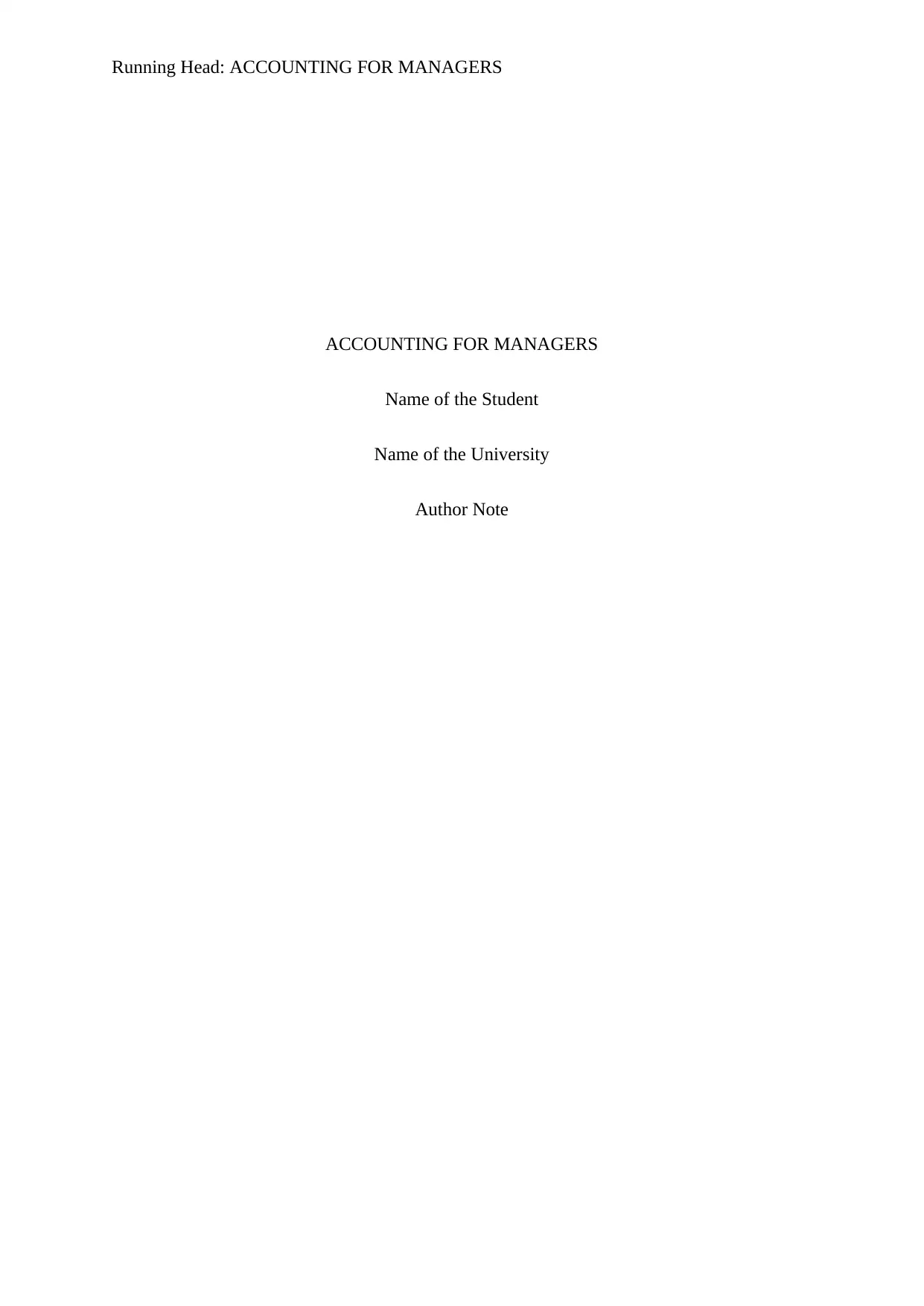
Running Head: ACCOUNTING FOR MANAGERS
ACCOUNTING FOR MANAGERS
Name of the Student
Name of the University
Author Note
ACCOUNTING FOR MANAGERS
Name of the Student
Name of the University
Author Note
Paraphrase This Document
Need a fresh take? Get an instant paraphrase of this document with our AI Paraphraser
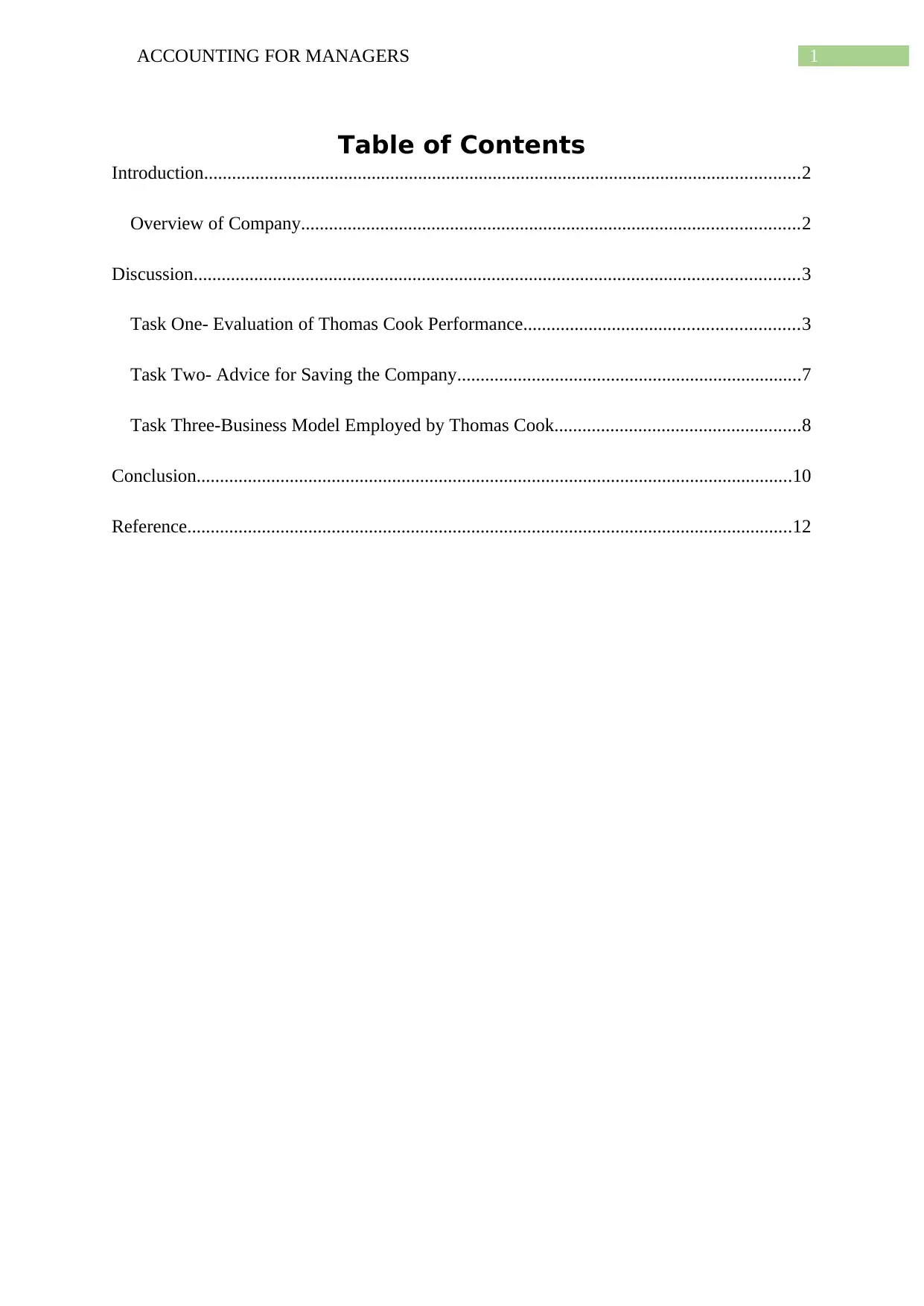
1ACCOUNTING FOR MANAGERS
Table of Contents
Introduction................................................................................................................................2
Overview of Company...........................................................................................................2
Discussion..................................................................................................................................3
Task One- Evaluation of Thomas Cook Performance...........................................................3
Task Two- Advice for Saving the Company..........................................................................7
Task Three-Business Model Employed by Thomas Cook.....................................................8
Conclusion................................................................................................................................10
Reference..................................................................................................................................12
Table of Contents
Introduction................................................................................................................................2
Overview of Company...........................................................................................................2
Discussion..................................................................................................................................3
Task One- Evaluation of Thomas Cook Performance...........................................................3
Task Two- Advice for Saving the Company..........................................................................7
Task Three-Business Model Employed by Thomas Cook.....................................................8
Conclusion................................................................................................................................10
Reference..................................................................................................................................12
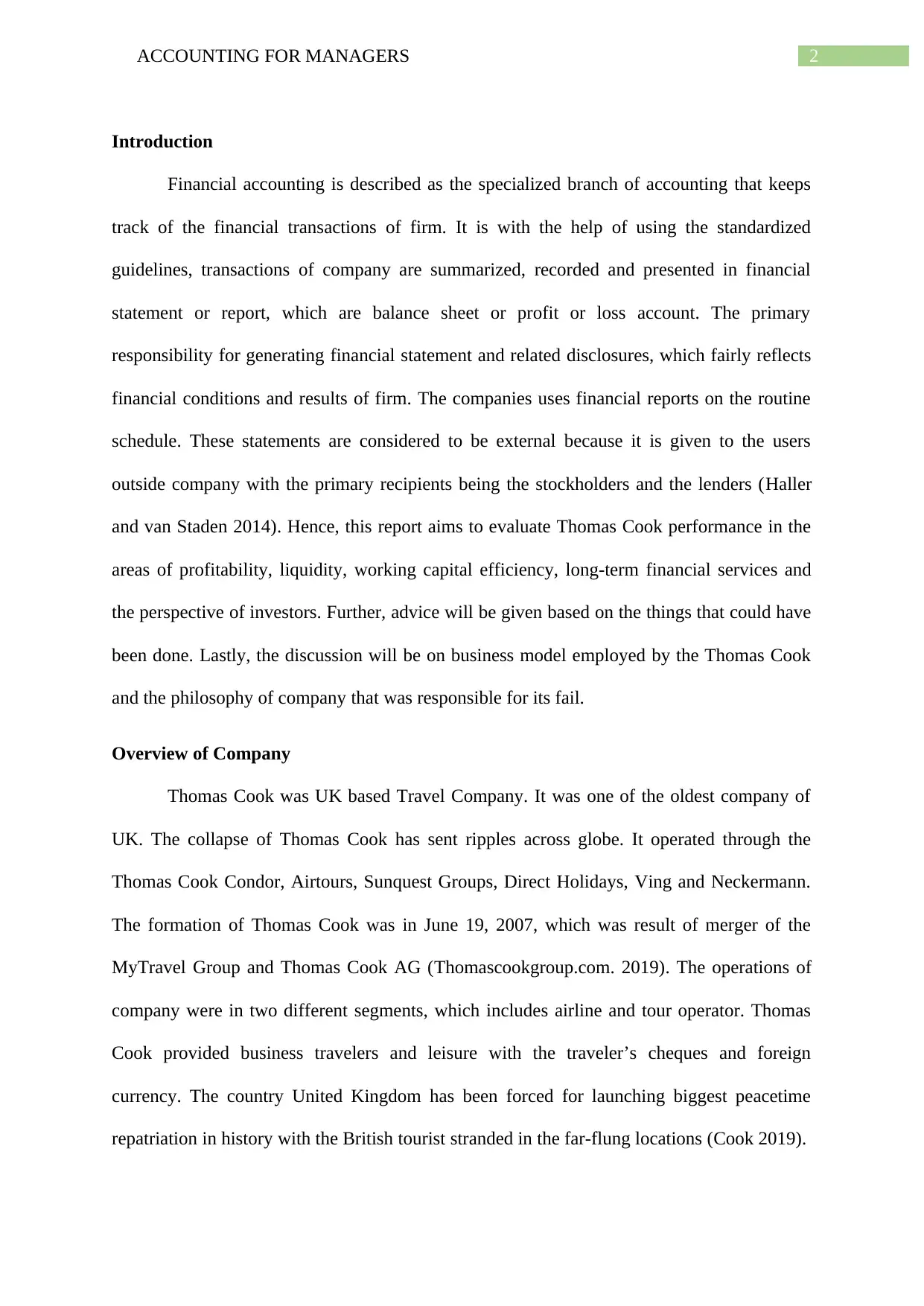
2ACCOUNTING FOR MANAGERS
Introduction
Financial accounting is described as the specialized branch of accounting that keeps
track of the financial transactions of firm. It is with the help of using the standardized
guidelines, transactions of company are summarized, recorded and presented in financial
statement or report, which are balance sheet or profit or loss account. The primary
responsibility for generating financial statement and related disclosures, which fairly reflects
financial conditions and results of firm. The companies uses financial reports on the routine
schedule. These statements are considered to be external because it is given to the users
outside company with the primary recipients being the stockholders and the lenders (Haller
and van Staden 2014). Hence, this report aims to evaluate Thomas Cook performance in the
areas of profitability, liquidity, working capital efficiency, long-term financial services and
the perspective of investors. Further, advice will be given based on the things that could have
been done. Lastly, the discussion will be on business model employed by the Thomas Cook
and the philosophy of company that was responsible for its fail.
Overview of Company
Thomas Cook was UK based Travel Company. It was one of the oldest company of
UK. The collapse of Thomas Cook has sent ripples across globe. It operated through the
Thomas Cook Condor, Airtours, Sunquest Groups, Direct Holidays, Ving and Neckermann.
The formation of Thomas Cook was in June 19, 2007, which was result of merger of the
MyTravel Group and Thomas Cook AG (Thomascookgroup.com. 2019). The operations of
company were in two different segments, which includes airline and tour operator. Thomas
Cook provided business travelers and leisure with the traveler’s cheques and foreign
currency. The country United Kingdom has been forced for launching biggest peacetime
repatriation in history with the British tourist stranded in the far-flung locations (Cook 2019).
Introduction
Financial accounting is described as the specialized branch of accounting that keeps
track of the financial transactions of firm. It is with the help of using the standardized
guidelines, transactions of company are summarized, recorded and presented in financial
statement or report, which are balance sheet or profit or loss account. The primary
responsibility for generating financial statement and related disclosures, which fairly reflects
financial conditions and results of firm. The companies uses financial reports on the routine
schedule. These statements are considered to be external because it is given to the users
outside company with the primary recipients being the stockholders and the lenders (Haller
and van Staden 2014). Hence, this report aims to evaluate Thomas Cook performance in the
areas of profitability, liquidity, working capital efficiency, long-term financial services and
the perspective of investors. Further, advice will be given based on the things that could have
been done. Lastly, the discussion will be on business model employed by the Thomas Cook
and the philosophy of company that was responsible for its fail.
Overview of Company
Thomas Cook was UK based Travel Company. It was one of the oldest company of
UK. The collapse of Thomas Cook has sent ripples across globe. It operated through the
Thomas Cook Condor, Airtours, Sunquest Groups, Direct Holidays, Ving and Neckermann.
The formation of Thomas Cook was in June 19, 2007, which was result of merger of the
MyTravel Group and Thomas Cook AG (Thomascookgroup.com. 2019). The operations of
company were in two different segments, which includes airline and tour operator. Thomas
Cook provided business travelers and leisure with the traveler’s cheques and foreign
currency. The country United Kingdom has been forced for launching biggest peacetime
repatriation in history with the British tourist stranded in the far-flung locations (Cook 2019).
⊘ This is a preview!⊘
Do you want full access?
Subscribe today to unlock all pages.

Trusted by 1+ million students worldwide
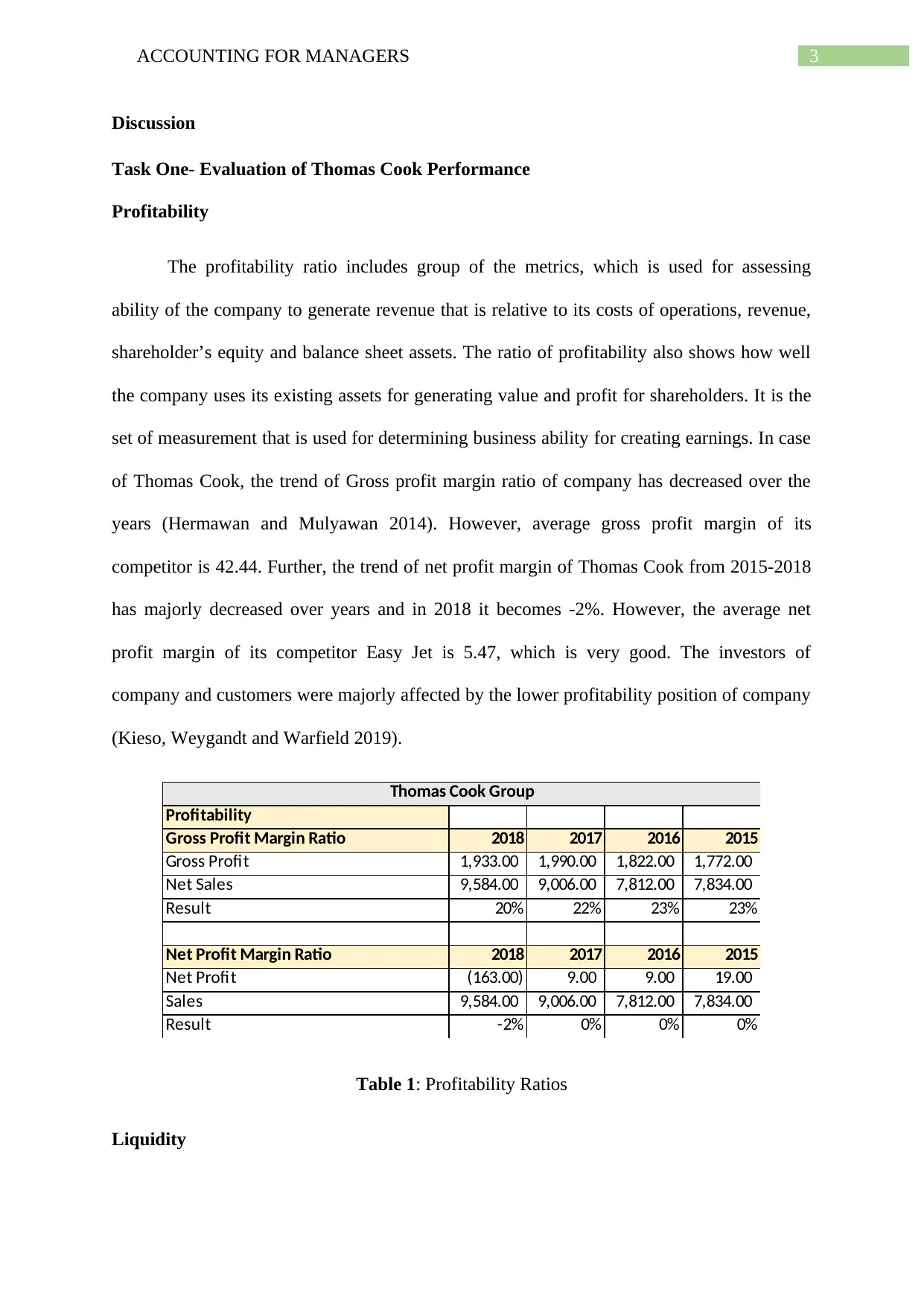
3ACCOUNTING FOR MANAGERS
Discussion
Task One- Evaluation of Thomas Cook Performance
Profitability
The profitability ratio includes group of the metrics, which is used for assessing
ability of the company to generate revenue that is relative to its costs of operations, revenue,
shareholder’s equity and balance sheet assets. The ratio of profitability also shows how well
the company uses its existing assets for generating value and profit for shareholders. It is the
set of measurement that is used for determining business ability for creating earnings. In case
of Thomas Cook, the trend of Gross profit margin ratio of company has decreased over the
years (Hermawan and Mulyawan 2014). However, average gross profit margin of its
competitor is 42.44. Further, the trend of net profit margin of Thomas Cook from 2015-2018
has majorly decreased over years and in 2018 it becomes -2%. However, the average net
profit margin of its competitor Easy Jet is 5.47, which is very good. The investors of
company and customers were majorly affected by the lower profitability position of company
(Kieso, Weygandt and Warfield 2019).
Profitability
Gross Profit Margin Ratio 2018 2017 2016 2015
Gross Profit 1,933.00 1,990.00 1,822.00 1,772.00
Net Sales 9,584.00 9,006.00 7,812.00 7,834.00
Result 20% 22% 23% 23%
Net Profit Margin Ratio 2018 2017 2016 2015
Net Profit (163.00) 9.00 9.00 19.00
Sales 9,584.00 9,006.00 7,812.00 7,834.00
Result -2% 0% 0% 0%
Thomas Cook Group
Table 1: Profitability Ratios
Liquidity
Discussion
Task One- Evaluation of Thomas Cook Performance
Profitability
The profitability ratio includes group of the metrics, which is used for assessing
ability of the company to generate revenue that is relative to its costs of operations, revenue,
shareholder’s equity and balance sheet assets. The ratio of profitability also shows how well
the company uses its existing assets for generating value and profit for shareholders. It is the
set of measurement that is used for determining business ability for creating earnings. In case
of Thomas Cook, the trend of Gross profit margin ratio of company has decreased over the
years (Hermawan and Mulyawan 2014). However, average gross profit margin of its
competitor is 42.44. Further, the trend of net profit margin of Thomas Cook from 2015-2018
has majorly decreased over years and in 2018 it becomes -2%. However, the average net
profit margin of its competitor Easy Jet is 5.47, which is very good. The investors of
company and customers were majorly affected by the lower profitability position of company
(Kieso, Weygandt and Warfield 2019).
Profitability
Gross Profit Margin Ratio 2018 2017 2016 2015
Gross Profit 1,933.00 1,990.00 1,822.00 1,772.00
Net Sales 9,584.00 9,006.00 7,812.00 7,834.00
Result 20% 22% 23% 23%
Net Profit Margin Ratio 2018 2017 2016 2015
Net Profit (163.00) 9.00 9.00 19.00
Sales 9,584.00 9,006.00 7,812.00 7,834.00
Result -2% 0% 0% 0%
Thomas Cook Group
Table 1: Profitability Ratios
Liquidity
Paraphrase This Document
Need a fresh take? Get an instant paraphrase of this document with our AI Paraphraser
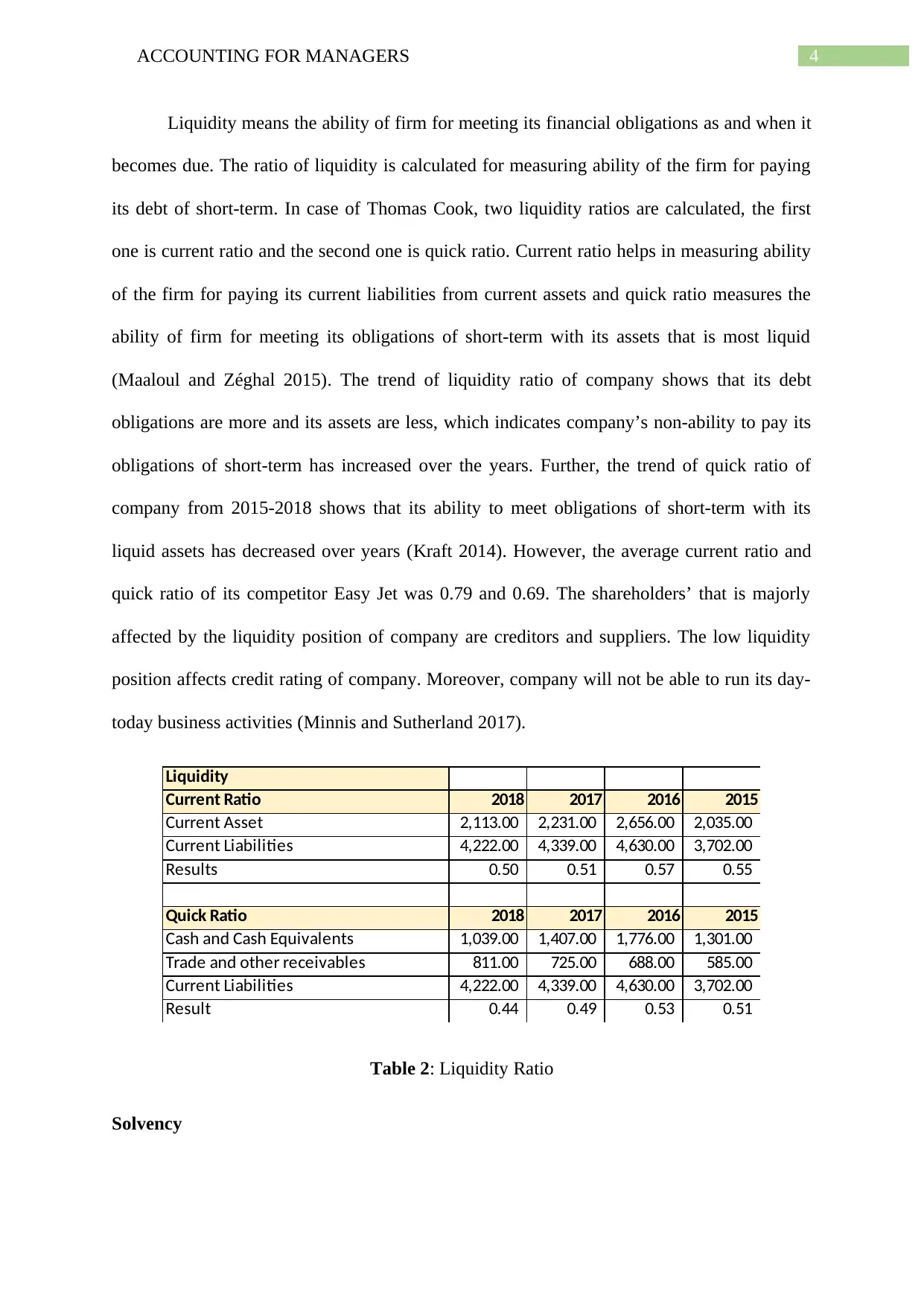
4ACCOUNTING FOR MANAGERS
Liquidity means the ability of firm for meeting its financial obligations as and when it
becomes due. The ratio of liquidity is calculated for measuring ability of the firm for paying
its debt of short-term. In case of Thomas Cook, two liquidity ratios are calculated, the first
one is current ratio and the second one is quick ratio. Current ratio helps in measuring ability
of the firm for paying its current liabilities from current assets and quick ratio measures the
ability of firm for meeting its obligations of short-term with its assets that is most liquid
(Maaloul and Zéghal 2015). The trend of liquidity ratio of company shows that its debt
obligations are more and its assets are less, which indicates company’s non-ability to pay its
obligations of short-term has increased over the years. Further, the trend of quick ratio of
company from 2015-2018 shows that its ability to meet obligations of short-term with its
liquid assets has decreased over years (Kraft 2014). However, the average current ratio and
quick ratio of its competitor Easy Jet was 0.79 and 0.69. The shareholders’ that is majorly
affected by the liquidity position of company are creditors and suppliers. The low liquidity
position affects credit rating of company. Moreover, company will not be able to run its day-
today business activities (Minnis and Sutherland 2017).
Liquidity
Current Ratio 2018 2017 2016 2015
Current Asset 2,113.00 2,231.00 2,656.00 2,035.00
Current Liabilities 4,222.00 4,339.00 4,630.00 3,702.00
Results 0.50 0.51 0.57 0.55
Quick Ratio 2018 2017 2016 2015
Cash and Cash Equivalents 1,039.00 1,407.00 1,776.00 1,301.00
Trade and other receivables 811.00 725.00 688.00 585.00
Current Liabilities 4,222.00 4,339.00 4,630.00 3,702.00
Result 0.44 0.49 0.53 0.51
Table 2: Liquidity Ratio
Solvency
Liquidity means the ability of firm for meeting its financial obligations as and when it
becomes due. The ratio of liquidity is calculated for measuring ability of the firm for paying
its debt of short-term. In case of Thomas Cook, two liquidity ratios are calculated, the first
one is current ratio and the second one is quick ratio. Current ratio helps in measuring ability
of the firm for paying its current liabilities from current assets and quick ratio measures the
ability of firm for meeting its obligations of short-term with its assets that is most liquid
(Maaloul and Zéghal 2015). The trend of liquidity ratio of company shows that its debt
obligations are more and its assets are less, which indicates company’s non-ability to pay its
obligations of short-term has increased over the years. Further, the trend of quick ratio of
company from 2015-2018 shows that its ability to meet obligations of short-term with its
liquid assets has decreased over years (Kraft 2014). However, the average current ratio and
quick ratio of its competitor Easy Jet was 0.79 and 0.69. The shareholders’ that is majorly
affected by the liquidity position of company are creditors and suppliers. The low liquidity
position affects credit rating of company. Moreover, company will not be able to run its day-
today business activities (Minnis and Sutherland 2017).
Liquidity
Current Ratio 2018 2017 2016 2015
Current Asset 2,113.00 2,231.00 2,656.00 2,035.00
Current Liabilities 4,222.00 4,339.00 4,630.00 3,702.00
Results 0.50 0.51 0.57 0.55
Quick Ratio 2018 2017 2016 2015
Cash and Cash Equivalents 1,039.00 1,407.00 1,776.00 1,301.00
Trade and other receivables 811.00 725.00 688.00 585.00
Current Liabilities 4,222.00 4,339.00 4,630.00 3,702.00
Result 0.44 0.49 0.53 0.51
Table 2: Liquidity Ratio
Solvency
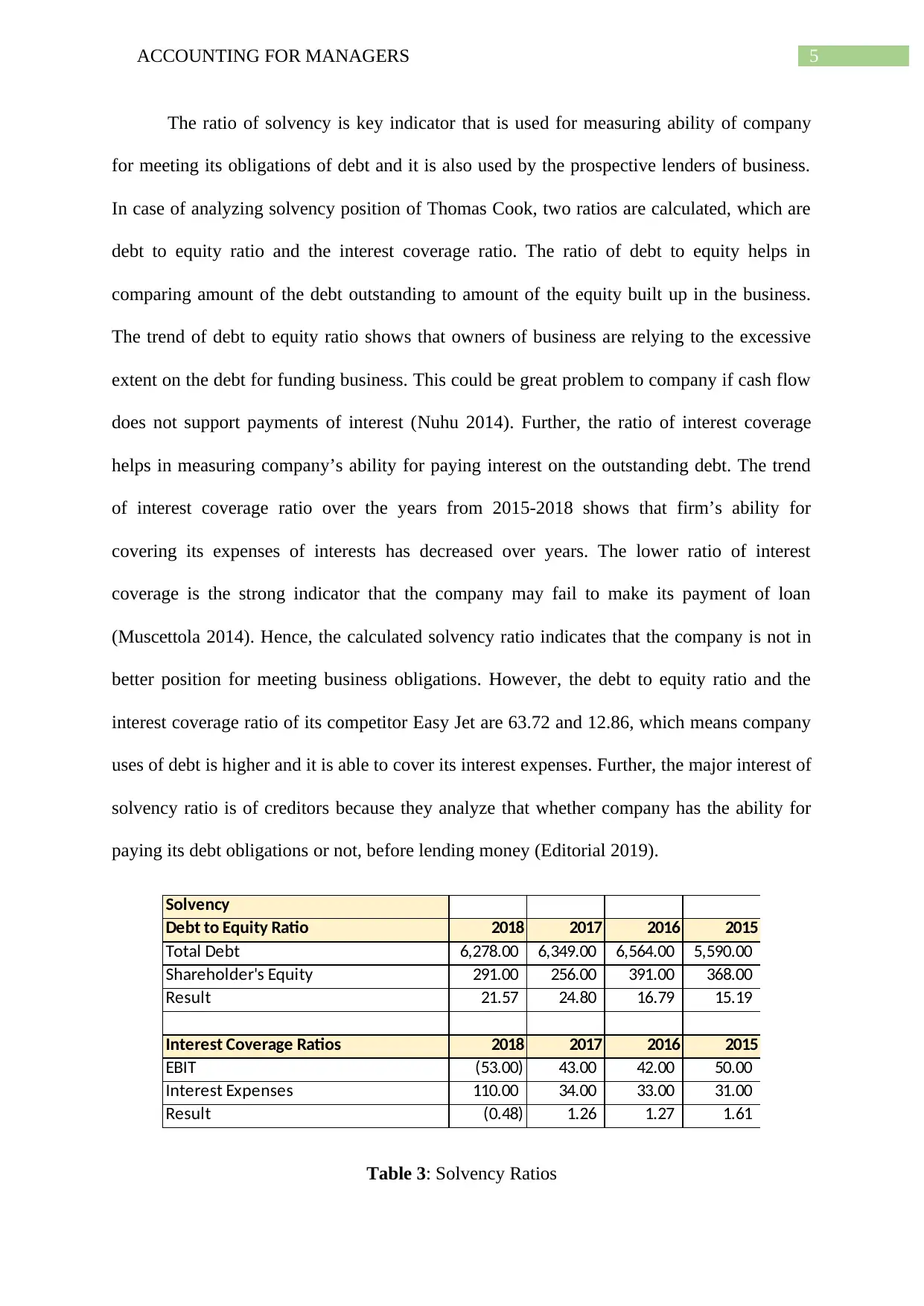
5ACCOUNTING FOR MANAGERS
The ratio of solvency is key indicator that is used for measuring ability of company
for meeting its obligations of debt and it is also used by the prospective lenders of business.
In case of analyzing solvency position of Thomas Cook, two ratios are calculated, which are
debt to equity ratio and the interest coverage ratio. The ratio of debt to equity helps in
comparing amount of the debt outstanding to amount of the equity built up in the business.
The trend of debt to equity ratio shows that owners of business are relying to the excessive
extent on the debt for funding business. This could be great problem to company if cash flow
does not support payments of interest (Nuhu 2014). Further, the ratio of interest coverage
helps in measuring company’s ability for paying interest on the outstanding debt. The trend
of interest coverage ratio over the years from 2015-2018 shows that firm’s ability for
covering its expenses of interests has decreased over years. The lower ratio of interest
coverage is the strong indicator that the company may fail to make its payment of loan
(Muscettola 2014). Hence, the calculated solvency ratio indicates that the company is not in
better position for meeting business obligations. However, the debt to equity ratio and the
interest coverage ratio of its competitor Easy Jet are 63.72 and 12.86, which means company
uses of debt is higher and it is able to cover its interest expenses. Further, the major interest of
solvency ratio is of creditors because they analyze that whether company has the ability for
paying its debt obligations or not, before lending money (Editorial 2019).
Solvency
Debt to Equity Ratio 2018 2017 2016 2015
Total Debt 6,278.00 6,349.00 6,564.00 5,590.00
Shareholder's Equity 291.00 256.00 391.00 368.00
Result 21.57 24.80 16.79 15.19
Interest Coverage Ratios 2018 2017 2016 2015
EBIT (53.00) 43.00 42.00 50.00
Interest Expenses 110.00 34.00 33.00 31.00
Result (0.48) 1.26 1.27 1.61
Table 3: Solvency Ratios
The ratio of solvency is key indicator that is used for measuring ability of company
for meeting its obligations of debt and it is also used by the prospective lenders of business.
In case of analyzing solvency position of Thomas Cook, two ratios are calculated, which are
debt to equity ratio and the interest coverage ratio. The ratio of debt to equity helps in
comparing amount of the debt outstanding to amount of the equity built up in the business.
The trend of debt to equity ratio shows that owners of business are relying to the excessive
extent on the debt for funding business. This could be great problem to company if cash flow
does not support payments of interest (Nuhu 2014). Further, the ratio of interest coverage
helps in measuring company’s ability for paying interest on the outstanding debt. The trend
of interest coverage ratio over the years from 2015-2018 shows that firm’s ability for
covering its expenses of interests has decreased over years. The lower ratio of interest
coverage is the strong indicator that the company may fail to make its payment of loan
(Muscettola 2014). Hence, the calculated solvency ratio indicates that the company is not in
better position for meeting business obligations. However, the debt to equity ratio and the
interest coverage ratio of its competitor Easy Jet are 63.72 and 12.86, which means company
uses of debt is higher and it is able to cover its interest expenses. Further, the major interest of
solvency ratio is of creditors because they analyze that whether company has the ability for
paying its debt obligations or not, before lending money (Editorial 2019).
Solvency
Debt to Equity Ratio 2018 2017 2016 2015
Total Debt 6,278.00 6,349.00 6,564.00 5,590.00
Shareholder's Equity 291.00 256.00 391.00 368.00
Result 21.57 24.80 16.79 15.19
Interest Coverage Ratios 2018 2017 2016 2015
EBIT (53.00) 43.00 42.00 50.00
Interest Expenses 110.00 34.00 33.00 31.00
Result (0.48) 1.26 1.27 1.61
Table 3: Solvency Ratios
⊘ This is a preview!⊘
Do you want full access?
Subscribe today to unlock all pages.

Trusted by 1+ million students worldwide
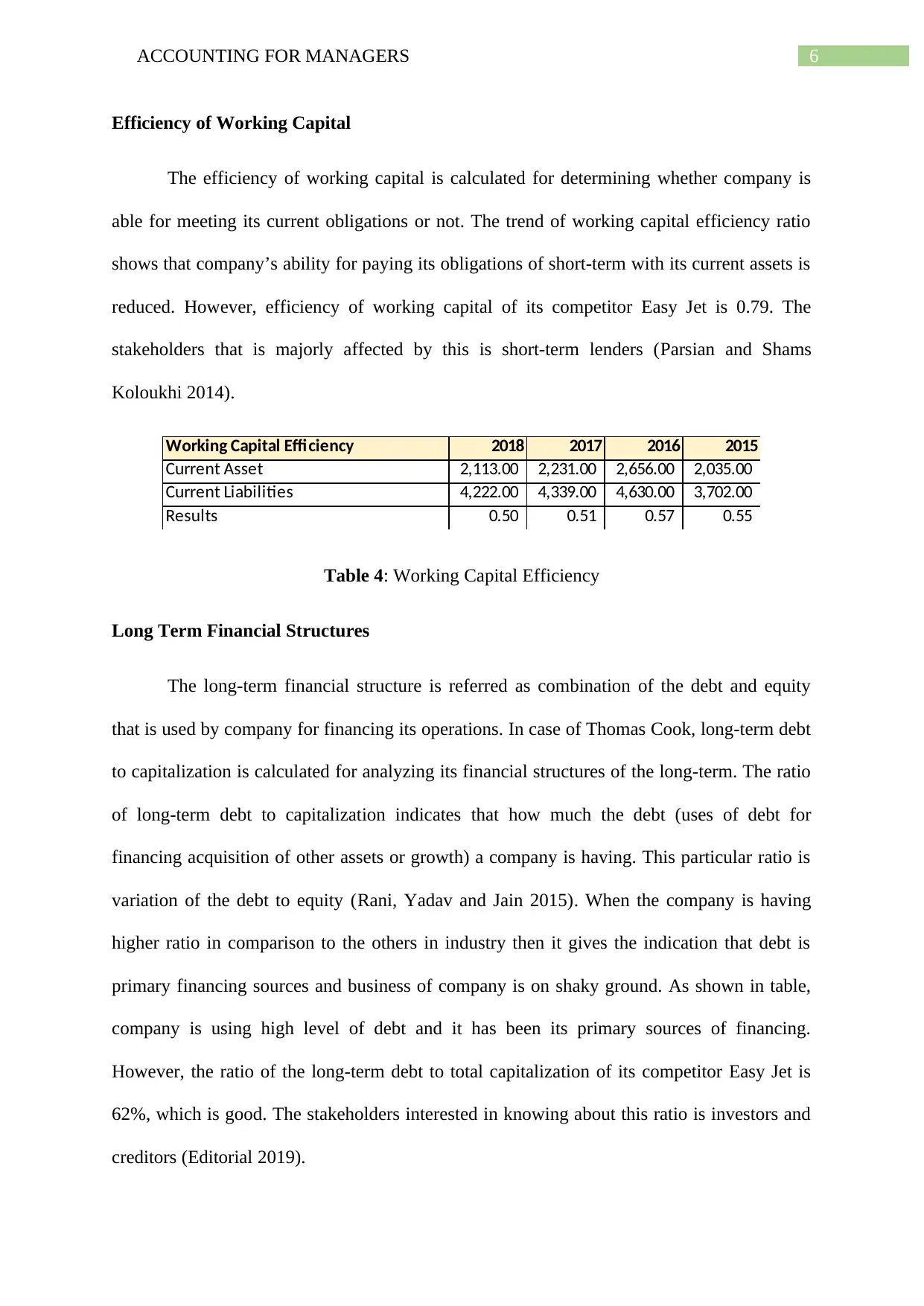
6ACCOUNTING FOR MANAGERS
Efficiency of Working Capital
The efficiency of working capital is calculated for determining whether company is
able for meeting its current obligations or not. The trend of working capital efficiency ratio
shows that company’s ability for paying its obligations of short-term with its current assets is
reduced. However, efficiency of working capital of its competitor Easy Jet is 0.79. The
stakeholders that is majorly affected by this is short-term lenders (Parsian and Shams
Koloukhi 2014).
Working Capital Efficiency 2018 2017 2016 2015
Current Asset 2,113.00 2,231.00 2,656.00 2,035.00
Current Liabilities 4,222.00 4,339.00 4,630.00 3,702.00
Results 0.50 0.51 0.57 0.55
Table 4: Working Capital Efficiency
Long Term Financial Structures
The long-term financial structure is referred as combination of the debt and equity
that is used by company for financing its operations. In case of Thomas Cook, long-term debt
to capitalization is calculated for analyzing its financial structures of the long-term. The ratio
of long-term debt to capitalization indicates that how much the debt (uses of debt for
financing acquisition of other assets or growth) a company is having. This particular ratio is
variation of the debt to equity (Rani, Yadav and Jain 2015). When the company is having
higher ratio in comparison to the others in industry then it gives the indication that debt is
primary financing sources and business of company is on shaky ground. As shown in table,
company is using high level of debt and it has been its primary sources of financing.
However, the ratio of the long-term debt to total capitalization of its competitor Easy Jet is
62%, which is good. The stakeholders interested in knowing about this ratio is investors and
creditors (Editorial 2019).
Efficiency of Working Capital
The efficiency of working capital is calculated for determining whether company is
able for meeting its current obligations or not. The trend of working capital efficiency ratio
shows that company’s ability for paying its obligations of short-term with its current assets is
reduced. However, efficiency of working capital of its competitor Easy Jet is 0.79. The
stakeholders that is majorly affected by this is short-term lenders (Parsian and Shams
Koloukhi 2014).
Working Capital Efficiency 2018 2017 2016 2015
Current Asset 2,113.00 2,231.00 2,656.00 2,035.00
Current Liabilities 4,222.00 4,339.00 4,630.00 3,702.00
Results 0.50 0.51 0.57 0.55
Table 4: Working Capital Efficiency
Long Term Financial Structures
The long-term financial structure is referred as combination of the debt and equity
that is used by company for financing its operations. In case of Thomas Cook, long-term debt
to capitalization is calculated for analyzing its financial structures of the long-term. The ratio
of long-term debt to capitalization indicates that how much the debt (uses of debt for
financing acquisition of other assets or growth) a company is having. This particular ratio is
variation of the debt to equity (Rani, Yadav and Jain 2015). When the company is having
higher ratio in comparison to the others in industry then it gives the indication that debt is
primary financing sources and business of company is on shaky ground. As shown in table,
company is using high level of debt and it has been its primary sources of financing.
However, the ratio of the long-term debt to total capitalization of its competitor Easy Jet is
62%, which is good. The stakeholders interested in knowing about this ratio is investors and
creditors (Editorial 2019).
Paraphrase This Document
Need a fresh take? Get an instant paraphrase of this document with our AI Paraphraser
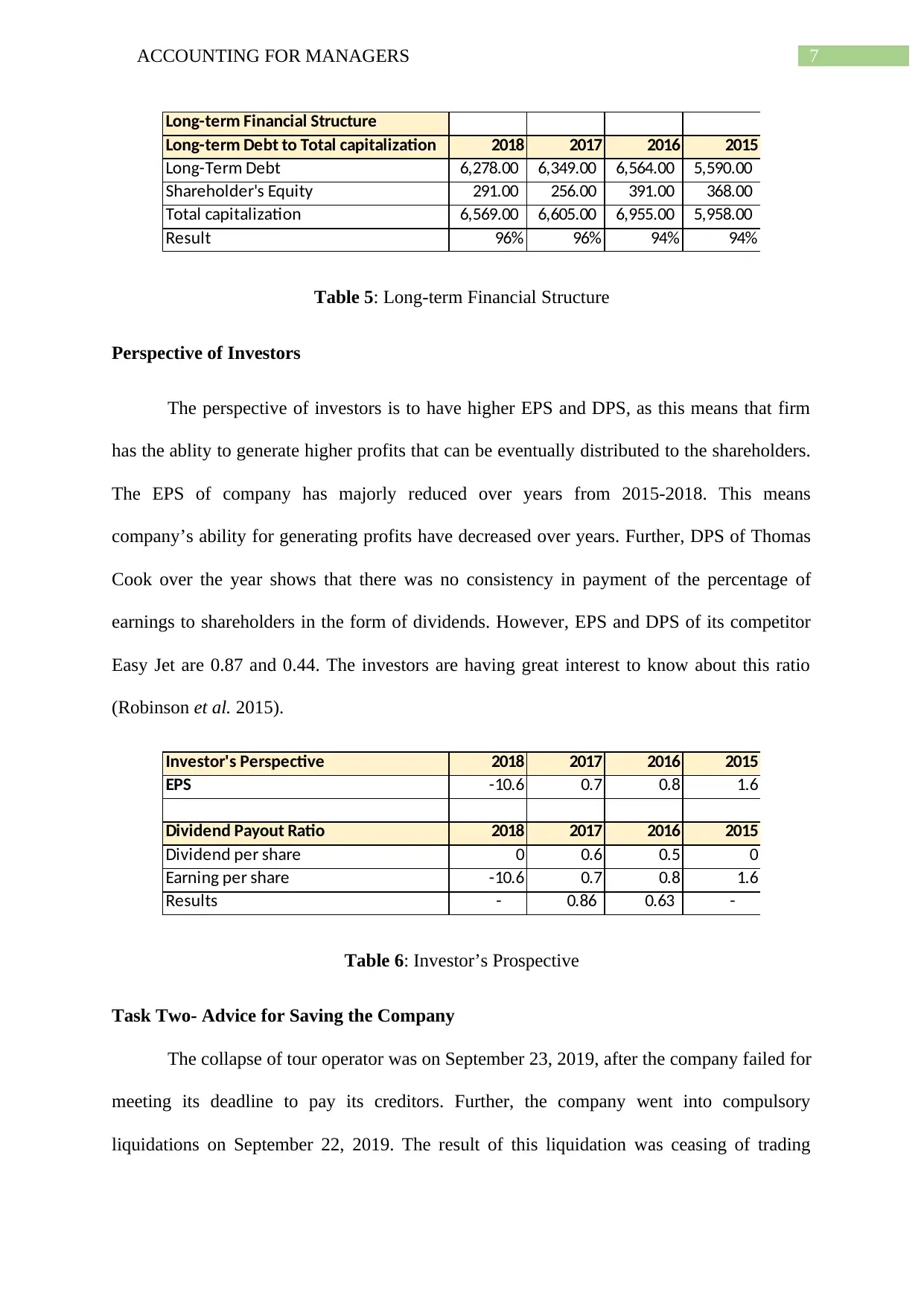
7ACCOUNTING FOR MANAGERS
Long-term Financial Structure
Long-term Debt to Total capitalization 2018 2017 2016 2015
Long-Term Debt 6,278.00 6,349.00 6,564.00 5,590.00
Shareholder's Equity 291.00 256.00 391.00 368.00
Total capitalization 6,569.00 6,605.00 6,955.00 5,958.00
Result 96% 96% 94% 94%
Table 5: Long-term Financial Structure
Perspective of Investors
The perspective of investors is to have higher EPS and DPS, as this means that firm
has the ablity to generate higher profits that can be eventually distributed to the shareholders.
The EPS of company has majorly reduced over years from 2015-2018. This means
company’s ability for generating profits have decreased over years. Further, DPS of Thomas
Cook over the year shows that there was no consistency in payment of the percentage of
earnings to shareholders in the form of dividends. However, EPS and DPS of its competitor
Easy Jet are 0.87 and 0.44. The investors are having great interest to know about this ratio
(Robinson et al. 2015).
Investor's Perspective 2018 2017 2016 2015
EPS -10.6 0.7 0.8 1.6
Dividend Payout Ratio 2018 2017 2016 2015
Dividend per share 0 0.6 0.5 0
Earning per share -10.6 0.7 0.8 1.6
Results - 0.86 0.63 -
Table 6: Investor’s Prospective
Task Two- Advice for Saving the Company
The collapse of tour operator was on September 23, 2019, after the company failed for
meeting its deadline to pay its creditors. Further, the company went into compulsory
liquidations on September 22, 2019. The result of this liquidation was ceasing of trading
Long-term Financial Structure
Long-term Debt to Total capitalization 2018 2017 2016 2015
Long-Term Debt 6,278.00 6,349.00 6,564.00 5,590.00
Shareholder's Equity 291.00 256.00 391.00 368.00
Total capitalization 6,569.00 6,605.00 6,955.00 5,958.00
Result 96% 96% 94% 94%
Table 5: Long-term Financial Structure
Perspective of Investors
The perspective of investors is to have higher EPS and DPS, as this means that firm
has the ablity to generate higher profits that can be eventually distributed to the shareholders.
The EPS of company has majorly reduced over years from 2015-2018. This means
company’s ability for generating profits have decreased over years. Further, DPS of Thomas
Cook over the year shows that there was no consistency in payment of the percentage of
earnings to shareholders in the form of dividends. However, EPS and DPS of its competitor
Easy Jet are 0.87 and 0.44. The investors are having great interest to know about this ratio
(Robinson et al. 2015).
Investor's Perspective 2018 2017 2016 2015
EPS -10.6 0.7 0.8 1.6
Dividend Payout Ratio 2018 2017 2016 2015
Dividend per share 0 0.6 0.5 0
Earning per share -10.6 0.7 0.8 1.6
Results - 0.86 0.63 -
Table 6: Investor’s Prospective
Task Two- Advice for Saving the Company
The collapse of tour operator was on September 23, 2019, after the company failed for
meeting its deadline to pay its creditors. Further, the company went into compulsory
liquidations on September 22, 2019. The result of this liquidation was ceasing of trading
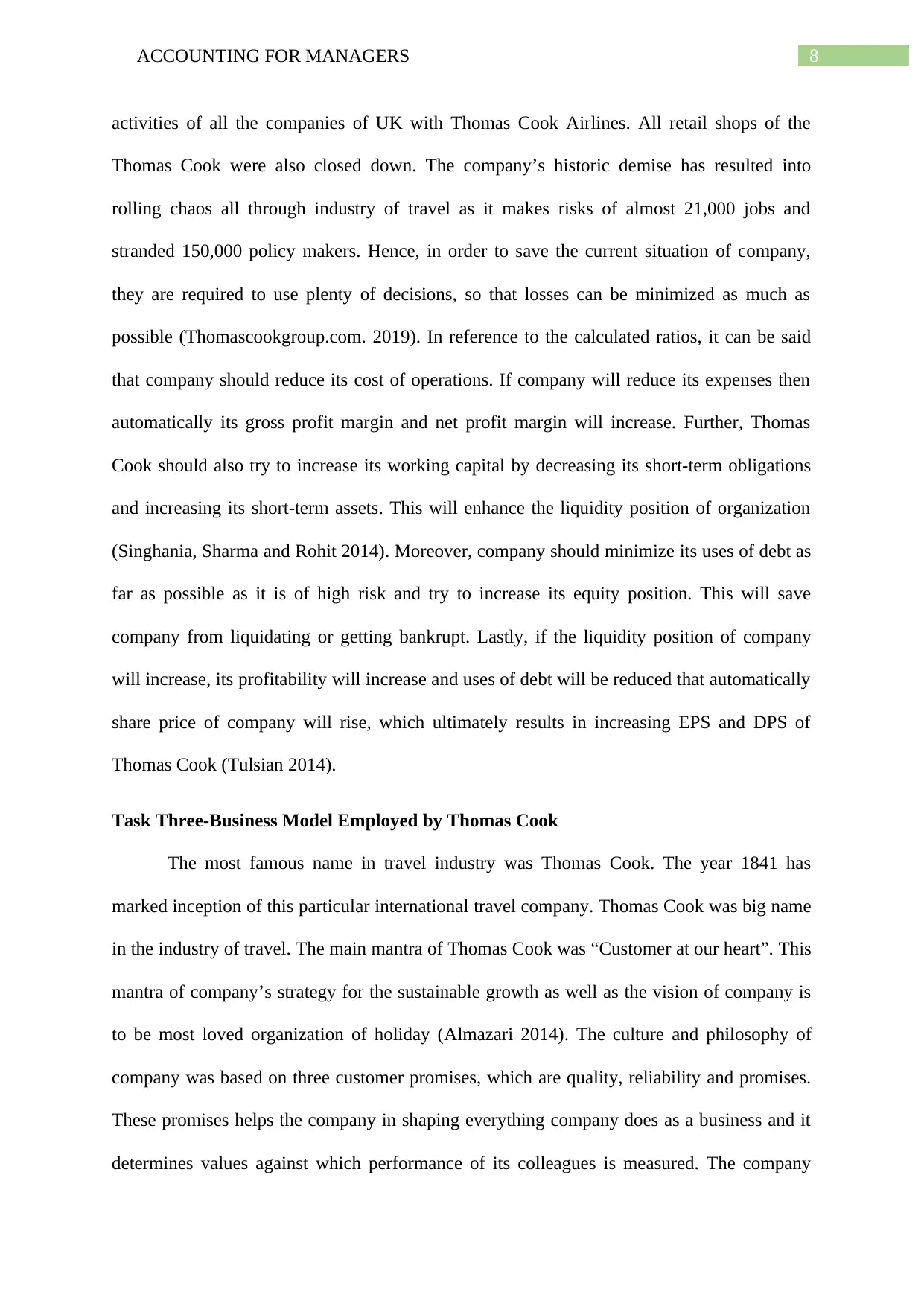
8ACCOUNTING FOR MANAGERS
activities of all the companies of UK with Thomas Cook Airlines. All retail shops of the
Thomas Cook were also closed down. The company’s historic demise has resulted into
rolling chaos all through industry of travel as it makes risks of almost 21,000 jobs and
stranded 150,000 policy makers. Hence, in order to save the current situation of company,
they are required to use plenty of decisions, so that losses can be minimized as much as
possible (Thomascookgroup.com. 2019). In reference to the calculated ratios, it can be said
that company should reduce its cost of operations. If company will reduce its expenses then
automatically its gross profit margin and net profit margin will increase. Further, Thomas
Cook should also try to increase its working capital by decreasing its short-term obligations
and increasing its short-term assets. This will enhance the liquidity position of organization
(Singhania, Sharma and Rohit 2014). Moreover, company should minimize its uses of debt as
far as possible as it is of high risk and try to increase its equity position. This will save
company from liquidating or getting bankrupt. Lastly, if the liquidity position of company
will increase, its profitability will increase and uses of debt will be reduced that automatically
share price of company will rise, which ultimately results in increasing EPS and DPS of
Thomas Cook (Tulsian 2014).
Task Three-Business Model Employed by Thomas Cook
The most famous name in travel industry was Thomas Cook. The year 1841 has
marked inception of this particular international travel company. Thomas Cook was big name
in the industry of travel. The main mantra of Thomas Cook was “Customer at our heart”. This
mantra of company’s strategy for the sustainable growth as well as the vision of company is
to be most loved organization of holiday (Almazari 2014). The culture and philosophy of
company was based on three customer promises, which are quality, reliability and promises.
These promises helps the company in shaping everything company does as a business and it
determines values against which performance of its colleagues is measured. The company
activities of all the companies of UK with Thomas Cook Airlines. All retail shops of the
Thomas Cook were also closed down. The company’s historic demise has resulted into
rolling chaos all through industry of travel as it makes risks of almost 21,000 jobs and
stranded 150,000 policy makers. Hence, in order to save the current situation of company,
they are required to use plenty of decisions, so that losses can be minimized as much as
possible (Thomascookgroup.com. 2019). In reference to the calculated ratios, it can be said
that company should reduce its cost of operations. If company will reduce its expenses then
automatically its gross profit margin and net profit margin will increase. Further, Thomas
Cook should also try to increase its working capital by decreasing its short-term obligations
and increasing its short-term assets. This will enhance the liquidity position of organization
(Singhania, Sharma and Rohit 2014). Moreover, company should minimize its uses of debt as
far as possible as it is of high risk and try to increase its equity position. This will save
company from liquidating or getting bankrupt. Lastly, if the liquidity position of company
will increase, its profitability will increase and uses of debt will be reduced that automatically
share price of company will rise, which ultimately results in increasing EPS and DPS of
Thomas Cook (Tulsian 2014).
Task Three-Business Model Employed by Thomas Cook
The most famous name in travel industry was Thomas Cook. The year 1841 has
marked inception of this particular international travel company. Thomas Cook was big name
in the industry of travel. The main mantra of Thomas Cook was “Customer at our heart”. This
mantra of company’s strategy for the sustainable growth as well as the vision of company is
to be most loved organization of holiday (Almazari 2014). The culture and philosophy of
company was based on three customer promises, which are quality, reliability and promises.
These promises helps the company in shaping everything company does as a business and it
determines values against which performance of its colleagues is measured. The company
⊘ This is a preview!⊘
Do you want full access?
Subscribe today to unlock all pages.

Trusted by 1+ million students worldwide
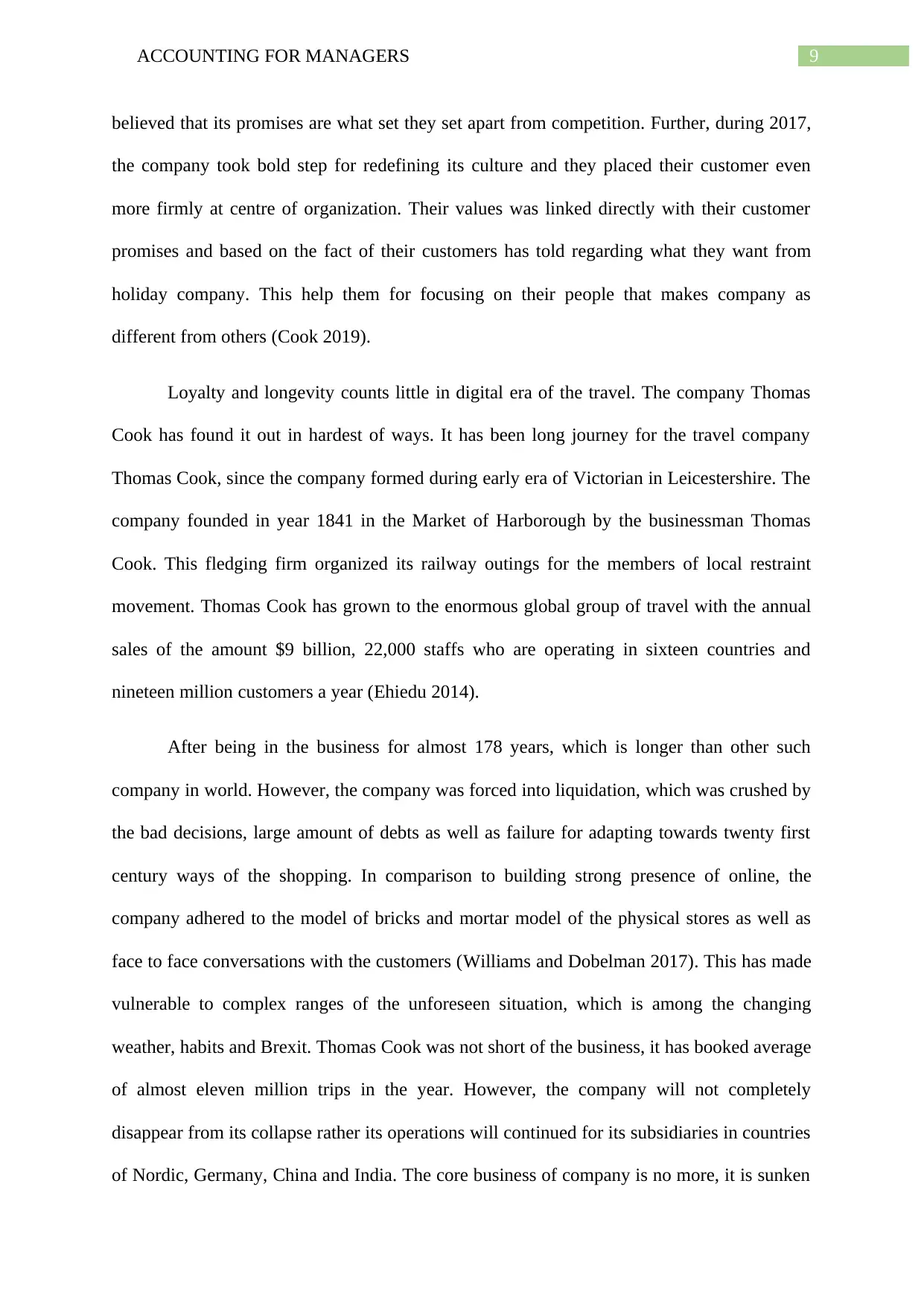
9ACCOUNTING FOR MANAGERS
believed that its promises are what set they set apart from competition. Further, during 2017,
the company took bold step for redefining its culture and they placed their customer even
more firmly at centre of organization. Their values was linked directly with their customer
promises and based on the fact of their customers has told regarding what they want from
holiday company. This help them for focusing on their people that makes company as
different from others (Cook 2019).
Loyalty and longevity counts little in digital era of the travel. The company Thomas
Cook has found it out in hardest of ways. It has been long journey for the travel company
Thomas Cook, since the company formed during early era of Victorian in Leicestershire. The
company founded in year 1841 in the Market of Harborough by the businessman Thomas
Cook. This fledging firm organized its railway outings for the members of local restraint
movement. Thomas Cook has grown to the enormous global group of travel with the annual
sales of the amount $9 billion, 22,000 staffs who are operating in sixteen countries and
nineteen million customers a year (Ehiedu 2014).
After being in the business for almost 178 years, which is longer than other such
company in world. However, the company was forced into liquidation, which was crushed by
the bad decisions, large amount of debts as well as failure for adapting towards twenty first
century ways of the shopping. In comparison to building strong presence of online, the
company adhered to the model of bricks and mortar model of the physical stores as well as
face to face conversations with the customers (Williams and Dobelman 2017). This has made
vulnerable to complex ranges of the unforeseen situation, which is among the changing
weather, habits and Brexit. Thomas Cook was not short of the business, it has booked average
of almost eleven million trips in the year. However, the company will not completely
disappear from its collapse rather its operations will continued for its subsidiaries in countries
of Nordic, Germany, China and India. The core business of company is no more, it is sunken
believed that its promises are what set they set apart from competition. Further, during 2017,
the company took bold step for redefining its culture and they placed their customer even
more firmly at centre of organization. Their values was linked directly with their customer
promises and based on the fact of their customers has told regarding what they want from
holiday company. This help them for focusing on their people that makes company as
different from others (Cook 2019).
Loyalty and longevity counts little in digital era of the travel. The company Thomas
Cook has found it out in hardest of ways. It has been long journey for the travel company
Thomas Cook, since the company formed during early era of Victorian in Leicestershire. The
company founded in year 1841 in the Market of Harborough by the businessman Thomas
Cook. This fledging firm organized its railway outings for the members of local restraint
movement. Thomas Cook has grown to the enormous global group of travel with the annual
sales of the amount $9 billion, 22,000 staffs who are operating in sixteen countries and
nineteen million customers a year (Ehiedu 2014).
After being in the business for almost 178 years, which is longer than other such
company in world. However, the company was forced into liquidation, which was crushed by
the bad decisions, large amount of debts as well as failure for adapting towards twenty first
century ways of the shopping. In comparison to building strong presence of online, the
company adhered to the model of bricks and mortar model of the physical stores as well as
face to face conversations with the customers (Williams and Dobelman 2017). This has made
vulnerable to complex ranges of the unforeseen situation, which is among the changing
weather, habits and Brexit. Thomas Cook was not short of the business, it has booked average
of almost eleven million trips in the year. However, the company will not completely
disappear from its collapse rather its operations will continued for its subsidiaries in countries
of Nordic, Germany, China and India. The core business of company is no more, it is sunken
Paraphrase This Document
Need a fresh take? Get an instant paraphrase of this document with our AI Paraphraser
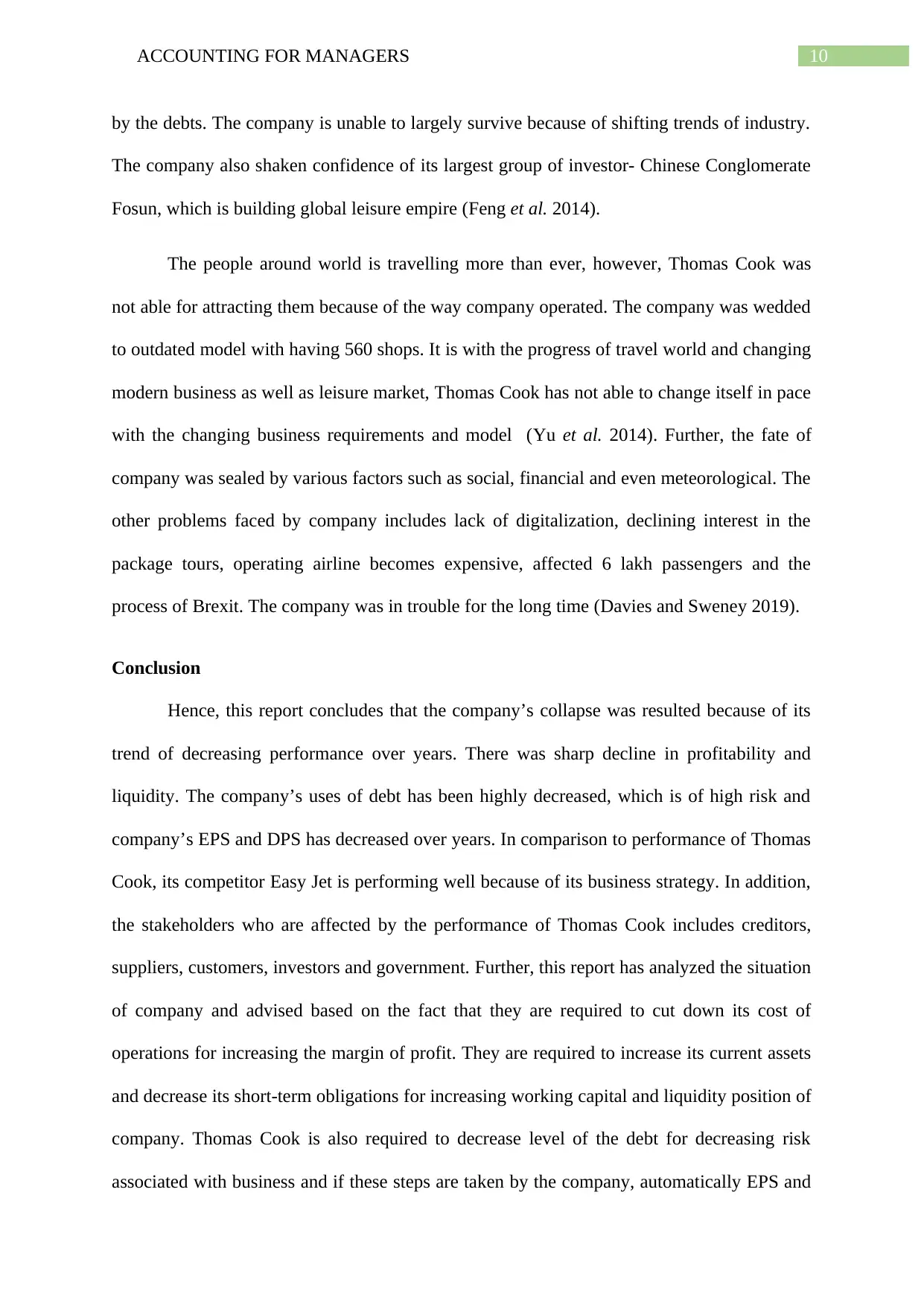
10ACCOUNTING FOR MANAGERS
by the debts. The company is unable to largely survive because of shifting trends of industry.
The company also shaken confidence of its largest group of investor- Chinese Conglomerate
Fosun, which is building global leisure empire (Feng et al. 2014).
The people around world is travelling more than ever, however, Thomas Cook was
not able for attracting them because of the way company operated. The company was wedded
to outdated model with having 560 shops. It is with the progress of travel world and changing
modern business as well as leisure market, Thomas Cook has not able to change itself in pace
with the changing business requirements and model (Yu et al. 2014). Further, the fate of
company was sealed by various factors such as social, financial and even meteorological. The
other problems faced by company includes lack of digitalization, declining interest in the
package tours, operating airline becomes expensive, affected 6 lakh passengers and the
process of Brexit. The company was in trouble for the long time (Davies and Sweney 2019).
Conclusion
Hence, this report concludes that the company’s collapse was resulted because of its
trend of decreasing performance over years. There was sharp decline in profitability and
liquidity. The company’s uses of debt has been highly decreased, which is of high risk and
company’s EPS and DPS has decreased over years. In comparison to performance of Thomas
Cook, its competitor Easy Jet is performing well because of its business strategy. In addition,
the stakeholders who are affected by the performance of Thomas Cook includes creditors,
suppliers, customers, investors and government. Further, this report has analyzed the situation
of company and advised based on the fact that they are required to cut down its cost of
operations for increasing the margin of profit. They are required to increase its current assets
and decrease its short-term obligations for increasing working capital and liquidity position of
company. Thomas Cook is also required to decrease level of the debt for decreasing risk
associated with business and if these steps are taken by the company, automatically EPS and
by the debts. The company is unable to largely survive because of shifting trends of industry.
The company also shaken confidence of its largest group of investor- Chinese Conglomerate
Fosun, which is building global leisure empire (Feng et al. 2014).
The people around world is travelling more than ever, however, Thomas Cook was
not able for attracting them because of the way company operated. The company was wedded
to outdated model with having 560 shops. It is with the progress of travel world and changing
modern business as well as leisure market, Thomas Cook has not able to change itself in pace
with the changing business requirements and model (Yu et al. 2014). Further, the fate of
company was sealed by various factors such as social, financial and even meteorological. The
other problems faced by company includes lack of digitalization, declining interest in the
package tours, operating airline becomes expensive, affected 6 lakh passengers and the
process of Brexit. The company was in trouble for the long time (Davies and Sweney 2019).
Conclusion
Hence, this report concludes that the company’s collapse was resulted because of its
trend of decreasing performance over years. There was sharp decline in profitability and
liquidity. The company’s uses of debt has been highly decreased, which is of high risk and
company’s EPS and DPS has decreased over years. In comparison to performance of Thomas
Cook, its competitor Easy Jet is performing well because of its business strategy. In addition,
the stakeholders who are affected by the performance of Thomas Cook includes creditors,
suppliers, customers, investors and government. Further, this report has analyzed the situation
of company and advised based on the fact that they are required to cut down its cost of
operations for increasing the margin of profit. They are required to increase its current assets
and decrease its short-term obligations for increasing working capital and liquidity position of
company. Thomas Cook is also required to decrease level of the debt for decreasing risk
associated with business and if these steps are taken by the company, automatically EPS and
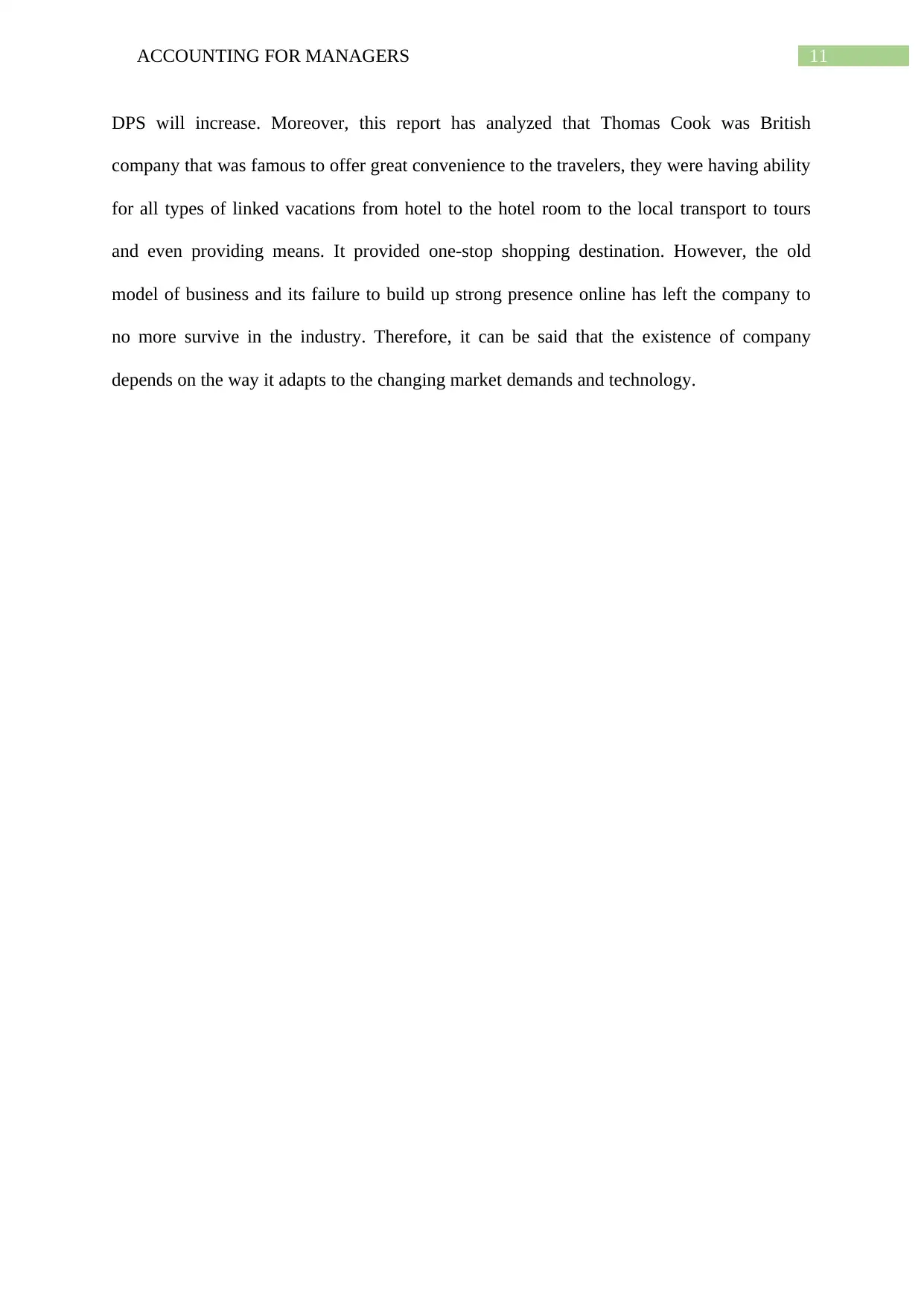
11ACCOUNTING FOR MANAGERS
DPS will increase. Moreover, this report has analyzed that Thomas Cook was British
company that was famous to offer great convenience to the travelers, they were having ability
for all types of linked vacations from hotel to the hotel room to the local transport to tours
and even providing means. It provided one-stop shopping destination. However, the old
model of business and its failure to build up strong presence online has left the company to
no more survive in the industry. Therefore, it can be said that the existence of company
depends on the way it adapts to the changing market demands and technology.
DPS will increase. Moreover, this report has analyzed that Thomas Cook was British
company that was famous to offer great convenience to the travelers, they were having ability
for all types of linked vacations from hotel to the hotel room to the local transport to tours
and even providing means. It provided one-stop shopping destination. However, the old
model of business and its failure to build up strong presence online has left the company to
no more survive in the industry. Therefore, it can be said that the existence of company
depends on the way it adapts to the changing market demands and technology.
⊘ This is a preview!⊘
Do you want full access?
Subscribe today to unlock all pages.

Trusted by 1+ million students worldwide
1 out of 15
Related Documents
Your All-in-One AI-Powered Toolkit for Academic Success.
+13062052269
info@desklib.com
Available 24*7 on WhatsApp / Email
![[object Object]](/_next/static/media/star-bottom.7253800d.svg)
Unlock your academic potential
Copyright © 2020–2025 A2Z Services. All Rights Reserved. Developed and managed by ZUCOL.





